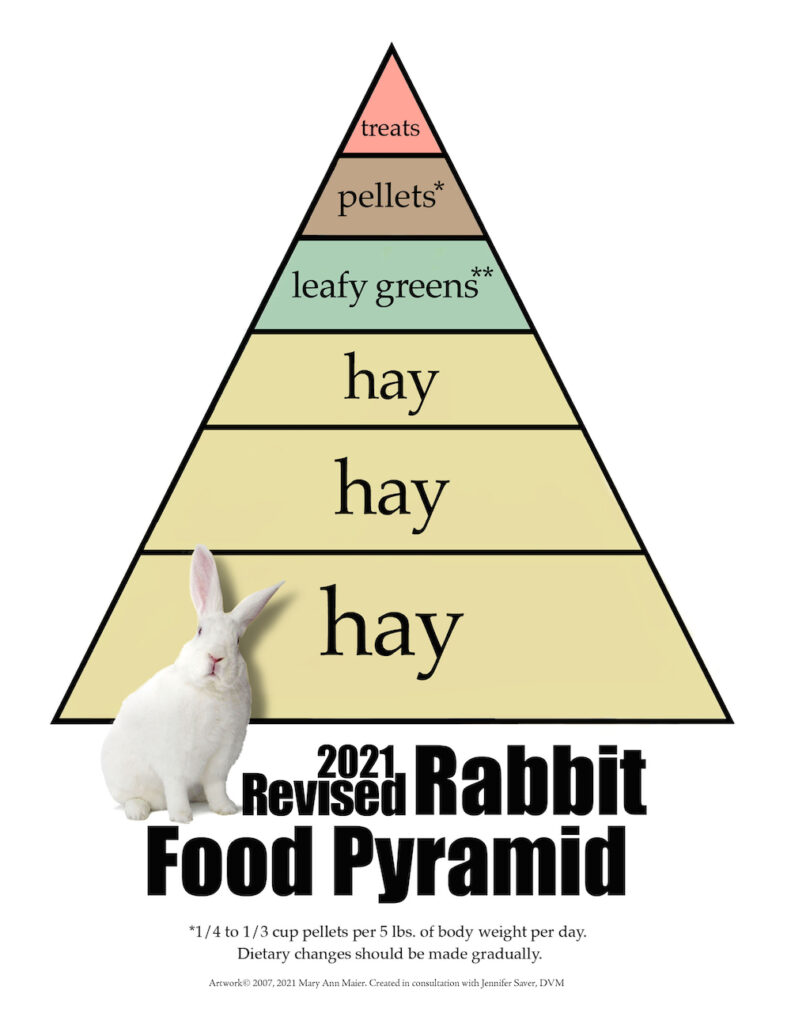Proper diet for your rabbit
A rabbit’s diet should consist of portioned, good-quality pellets, unlimited “grass” hay (timothy, oat, brome, orchard grass, etc.), fresh water and portioned leafy green vegetables.** Anything beyond that is a “treat” and should be given in very limited quantities.
Hay is essential to a rabbit’s diet and health—keeping his digestive system moving—and should be unlimited and available at all times. Only young rabbits should be fed alfalfa hay, and they should be introduced to timothy hay, grass hay, and oat hays at the age of 7 months to one year. (Oxbow, Sweet Meadow, American Pet Diner, Farmer Daves, Rabbit Hole Hay, Small Pet Select, One Ear Up)
Pellets: Fresh, high-fiber (20-25%), low-protein (14-15%) and low-calcium (<1%) pellets should be given in limited quantities depending on the rabbit’s age, metabolism and health. Any pet store pellet with colorful treats, corn or seeds should be avoided, as these are added purely to entice the human buying the product, and are unhealthy for your rabbit. (Oxbow, Sherwood Pet Health, Small Pet Select, Selective Science, American Pet Diner)
** Note we now recommend adult rabbits be served no more than 1 cup fresh leafy green vegetables per day. This is a smaller portion than previously recommended. We also advise that some rabbits cannot tolerate vegetables well, and these rabbits should be fed NO VEGETABLES WHATSOEVER.
Vegetables: Select at least three kinds of vegetables daily. Variety is necessary to obtain optimal nutrients, with one each day that contains Vitamin A, as indicated by an (A). Introduce vegetables one at a time. Eliminate if it causes soft stools or diarrhea.
Suggested Vegetables: Alfalfa, Basil, Beet tops(A), Bok choy, Carrot tops, Celery (must be chopped), Cilantro, Chicory, Clover (no pesticides), Collard greens(A), Dandelion greens and flowers (no pesticides)(A), Endive, Escarole, Fennel, Kale(!)(A), Mint, Mustard greens(A), Parsley(A), Spear/Peppermint leaves, Radicchio, Radish tops, Raspberry leaves, Red or green leaf lettuce, Romaine lettuce (no iceberg or light-colored leaf)(A), Spinach(!)(A), Turnip greens, Watercress(A)
(!)=Use sparingly. High in either oxalates or goitrogens and may be toxic in accumulated quantities over a period of time
Treats: Although pet store shelves are full of commercial rabbit treats, they should be avoided and healthy treats should be extremely limited. A healthy treat, for example, could be one baby carrot a day or a thin slice of banana or apple, or a few raisins. Papaya tablets are some rabbits’ favorite healthy treat. High-carbohydrate and high-sugar treats can cause health issues including obesity and digestive upset, which can kill a rabbit.
Fresh water should be available at all times either in a crock or water bottle.
See The House Rabbits Society’s diet page for more information.
Pyramid artwork ©2007 Mary Ann Maier. Created in consultation with Jennifer Saver, D.V.M., F
Babies
• Birth to 3 weeks: mother’s milk
• 3 to 7 weeks: mother’s milk, alfalfa and pellets
• 7 weeks to 7 months: unlimited pellets, unlimited hay
• 12 weeks: introduce vegetables (one at a time, quantities under 1/2 oz.)
Young Adults (7 months to 1 year)
• Introduce timothy hay, grass hay, and oat hays, decrease alfalfa
• Decrease pellets to 1/2 cup per 6 lbs. body weight
• Increase daily vegetables gradually
• Fruit daily ration no more than 1 oz. to 2 oz. per 6 lbs. body weight
Mature Adults (1 to 5 years)
• Unlimited timothy, grass hay, oat hay
• 1/4 to 1/2 cup pellets per 6 lbs. body weight
• Maximum 1 cup leafy green vegetables per 6lbs. body weight
• Fruit daily ration no more than 2 oz. (2 tbs.) per 6 lbs. body weight
Senior Rabbits (Over 6 years)
• If sufficient weight is maintained, continue adult diet
• Frail, older rabbits may need unrestricted pellets to keep weight up
• Alfalfa can be given to underweight rabbits, only if calcium levels are normal
• Twice-annual blood workups are highly recommended for geriatric rabbits